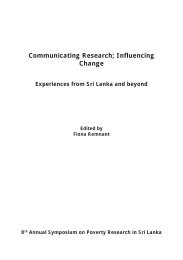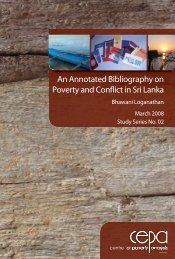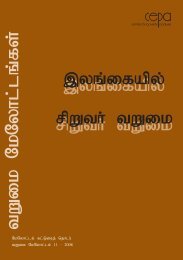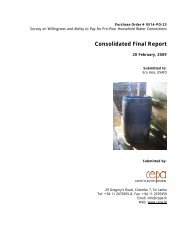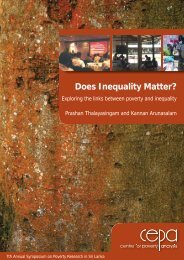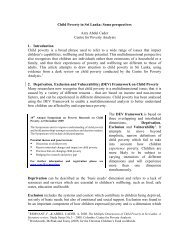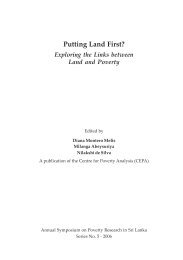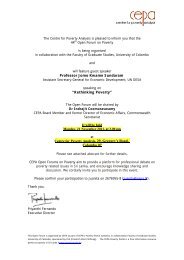Involuntary Displacement and Resettlement â Policy and ... - CEPA
Involuntary Displacement and Resettlement â Policy and ... - CEPA
Involuntary Displacement and Resettlement â Policy and ... - CEPA
- No tags were found...
Create successful ePaper yourself
Turn your PDF publications into a flip-book with our unique Google optimized e-Paper software.
this village suffered a more adverse economic impact than its neighbouring,government controlled, village of Mutur.The above scenario meant that all of the livelihoods of the Sampur peoplewere functioning below the potential level even at the time of theirdisplacement. Most important among these are paddy cultivation <strong>and</strong>fishing. Paddy cultivation uses urea as fertilizer <strong>and</strong> its restriction (due topotential use as a component in explosives) severely affected the averageyield (Korf 2004: 283; Abeyratne <strong>and</strong> Lakshman 2005). Fishing, which was amajor income earner in the North <strong>and</strong> East, was also severely affected by theconflict. Siluvaithasan <strong>and</strong> Stokke (2006) discuss in detail how deep-seafishing bans, other restrictions, <strong>and</strong> life threat to fishermen (all due to theconflict) have curtailed the output of what used to be a vibrant industry.While the Jaffna District alone provided 20-25% of the total fish productionin Sri Lanka before 1983, its contribution was reduced to 3-5% by the end ofthe Third Eelam War (Siluvaithasan <strong>and</strong> Stokke 2006: 240). This evidencesuggests that Sampur livelihoods too would have been functioning belowtheir potential level after the eruption of violent conflict in 1983. Though wecannot provide quantitative data in support of this assertion, the interviewswith key informants strongly support it.In addition to paddy cultivation <strong>and</strong> fishing there were many otherlivelihoods that were useful income providers in pre-displacement Sampur.Dry l<strong>and</strong> agriculture was a significant income generator. Banana, chillie <strong>and</strong>onion were grown in the dry l<strong>and</strong> plots. A limited number of farmers alsoengaged in chena cultivation. Cattle <strong>and</strong> buffalo owners earned significantincome from selling milk as well as calves. Chicken <strong>and</strong> goats also generatedincome, although less than cattle <strong>and</strong> buffalo.Ownerships of bullock carts was an important source of income. They wereused for transporting paddy from the fields, coral stones to the lime-kiln, etc.The bagged paddy <strong>and</strong> lime <strong>and</strong> also firewood were transported to Muturtown in carts, which earned significant amounts for the owners. In addition,the bullock was used to plough both paddy <strong>and</strong> dry l<strong>and</strong>s.All of the above livelihoods were based on some form of asset, such as paddyor dry l<strong>and</strong> <strong>and</strong> livestock. People also worked as casual labourers in paddyfields, dry l<strong>and</strong>s, lime-kilns <strong>and</strong> in fishing activities. Higher forms of humancapital such as masons <strong>and</strong> carpenters in Sampur earned even more thanthese casual labourers. Another important livelihood based on human capitalwas government service. In Sampur these constituted mainly of school72



